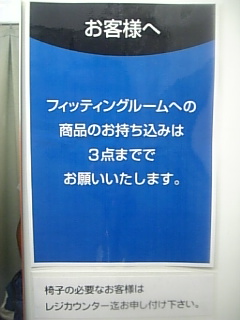Japan, as you might guess, is a bit of a hotbed of the Japanese language. The natural environment is ripe for sentence-mining. With that in mind, I’ve been taking pictures and collecting random everyday objects (advertisements, cereal boxes), with Japanese in them, to use for sentence-learning. You can do this outside of Japan, too, if you just buy lots of Japanese-language stuff, even food.
Anyway, so this comes from me buying clothes this past weekend.

Q: 服を着る
A: ふく を きる (PL2)
ふく【服】①着る物。衣服。
きる【着る】①衣服を身につける。「洋服を着る」「錦を着て故郷に帰る」
にしき【錦】立派な着物。 (This, by the way, is an example of a definition of a word in the definition. This is one of the cool things about using Japanese only, there’s this great recursion whereby one word leads you to the next
Clothes [object] wear
To wear clothes
Q: 服を試着する
A: ふく を し・ちゃく する(PL2)
ふく【服】
しちゃく【試着】体に合うかどうか試しに着て見ること。
Clothes [object] try-fit do
To try on clothes
Q: 試着室で服を着て見る
A: し・ちゃく・しつ で ふく を きて みる (PL2)
しちゃく【試着】体に合うかどうか試しに着て見ること。
しつ【室】部屋
へや【〈部屋〉】①家の中をいくつかに仕切ったものの一つ。室。間。
ふく【服】①着る物。衣服。
きる【着る】①衣服を身につける。「洋服を着る」「錦を着て故郷に帰る」
みる【見る】①「ある動作を試みにする」の意を表す
Fitting-room at clothes [object] wear-see
To try on clothes in the fitting room
■見る is used as an auxiliary (helper) verb. In this case, it’s helping the verb 着る (to wear). It has the meaning of (“try and see”), like “let’s try and see [if it works]”, a lot like in English.
Q: お客様へ
A: 御 きゃく さま へ (PL4)
[Honorable] customer [honorific] to
To our dear customers
■様(さま) is like さん, but even more polite. There is one word more polite than 様, and that is 殿(どの). I’ve only ever seen 殿 used in documents, in spoken language it seems to have become kind of archaic now.
Q: フィティングルームへの商品のお持込は3点まででお願いします
A: ふぃてぃんぐ るーむ への しょう・ひん の お もちこみ は 3 てん まで で お ねがい します (PL3-4)
Fitting-room [object] products/items [of] [honorable] bringing-in [as-for] 3 [counter] up-to [at] [honorable] request do
Please feel free to bring up to 3 items into the fitting room
(i.e. Please bring in no more than 3 items to the fitting room)
■持つ(もつ)= to hold/bring
■込む(こむ)= to insert/enter a lot of something
■持込む(もちこむ)= to bring in
■込む(こむ) is an auxiliary (helper) verb, that adds the meaning of inserting/entering (into) a place…
■する(する)= to do. します comes from する
■This sign on the inside says フィティングルーム, but the one on the outside says 試着室(し・ちゃく・しつ). Same meaning, but the kanji word seems more common to me.
■お願いします is very, very common in Japanese. It basically means “please”.
Q: 椅子の必要なお客様はレジカウンター迄お申し付け下さい
A: い・す の ひつ・よう な おきゃく・さま は(わ) れじ かうんたー まで おもうしつけ ください(PL4)
Chair [of] need [adjective-suffix] [honorable] customers [honorific] [as-for] register-counter up-to [honorable] notification please
Most honorable customers requiring a chair, kindly make your request known at the (cash) register counter
■申し付ける(もうしつける), to tell/order — always carries the connotation of someone higher (socially) talking to someone lower (socially). In this case, a customer to an employee at a business, since the customer is always right and all.
もうしつ・ける【申し付ける】〔上の者が下の者に対して〕言い渡す。言いつける。命令する。「何なりとお申し付け下さい」

The usefulness of these example packs can’t be overstated, thanks Khatz!
Um, in the second to last sentence, why does it say “持込” instead of ”持ち込み”? You wrote “mochikomi” for the hiragana but was that a mistake with the kanji or something I just don’t know about yet?